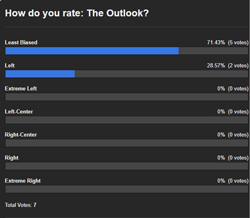The Outlook was listed among the least-biased sources of news, according to Media Bias/Fact Check (MBFC News), one of the most comprehensive resources for determining media bias.
According to the site, sources and stories for The Outlook have minimal bias, and stories use very few loaded words. The factual reporting is ranked as “high”, and MBFC News highlights that reporting is usually sourced, putting The Outlook among “the most credible media sources.”
An independent online media outlet, MBFC News was founded in 2015, and currently has over two thousand media sources in its database. Media publications can be searched by name or URLs. The site also features original articles about media bias, journalism, and politics.
The site uses a published methodology to rank the bias of media sources, including the use of four different categories to determine bias. The categories include the use of biased headlines and wording, the use of factual sourcing, the story choices made by the journalist, and the political affiliation of the journalist and the publication in general.
For each source, a minimum of ten headlines and five news stories are reviewed. Editorial and opinion pieces are also looked at, and the publication’s website is searched for various keywords to see how stories address terms such as “Republican,” “Democrat,” “Liberal,” and the names of political figures.
The site also looks at things such as bias by omission, bias by labeling, bias by placement, bias by selection of sources, bias by spin, bias by story selection, confirmation bias, the use of connotation and denotation, loaded words and language, and purr or snarl words.
“While The Outlook isn’t publishing the paper with the idea of ‘what awards will we win?’ – our focus, after all, is to bring fair and accurate news to the campus community – when we are recognized by outside entities, it often helps validate what we’re trying to do,” said John Morano, the faculty advisor to The Outlook and a professor of communication. “In this case particularly, being cited as a ‘least-biased’ publication is very satisfying.”
“When determining bias, there isn’t any true scientific formula that is 100 percent objective,” according to mediabiasfactcheck.com, the website for MBFC News. “There are objective measures that can be calculated, but ultimately there will be some degree of subjective judgement to determine these. On each page, we have put up a scale with a yellow dot that shows the degree of bias for each source.”
Placing the yellow dot is determined by the ranking of bias in the different categories. In each category, the source is rated on a scale of zero to ten. The four numbers are then added up and divided by four to provide an average. That number is then placed on the line, determining its bias.
Publications ranked between zero and two are qualified as “least biased”. Those between two and five are “center biased” on either the left or right side, and those between five and eight are “biased”. Sources that fall between eight and ten points are registered as having “extreme bias.”
According to the site, “When calculating bias, we are not just looking at political bias, but also how factual the information is and if they provide links to credible, verifiable sources.”
The site has also included a voting poll on each page for readers to vote on their opinion of the bias of the source. The poll allows for “two perspectives in which people can decide whom to trust,” according to the site, and “allows MBFC News to examine if the public is agreeing or disagreeing with our ratings. If there is a large enough discrepancy, we will re-examine that source and adjust accordingly after a thorough review.”
The poll for The Outlook has been voted in seven times. Five of those votes are for the “least biased” category, while two votes call it a “left-biased” source.
Other least-biased sources of news included the Associated Press, the Committee to Protect Journalists, and the Pulitzer-Prize winning International Consortium of Investigative Journalists. Other ranked student newspapers included The Varsity, a student-run newspaper based at the University of Toronto/Canada, which was rated as having a left-center bias, along with The Daily Tarheel, which is the student newspaper of the University of North Carolina at Chapel Hill. Other student newspapers ranked included The Daily 49er, a student-run newspaper from California State University, which had left bias.
“I think it is really important to be labeled as least-biased, because as a student newspaper, we are constantly learning and growing as journalists,” said Courtney Buell, a senior communication student and the Editor-In-Chief of The Outlook. “We strive to set an example of truth and objectivity, which is especially difficult when the university we attend is a large part of what we write about.”
“We put a lot of care into every story we write, and providing reliable news for our community is what is most important to us at the The Outlook,” said Buell.
IMAGE TAKEN from mediabiasfactcheck.com


